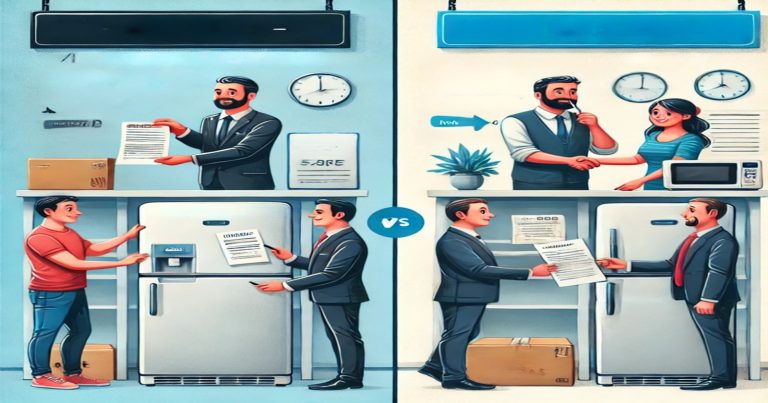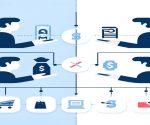The difference between sale and hire purchase primarily pertains to the transfer of ownership and the payment method. In a sale, the buyer pays the totality of the amount immediately or as agreed upon, and ownership of the goods transfers instantly. The purchaser is the legal owner and is free to use or resell the product. Sales are simple transactions and are recorded as revenue in the seller’s books when they are completed. In a hire purchase the purchaser undertakes to pay for the goods by instalments. Until the last installment is paid, the ownership does not pass. The buyer has possession and can use the goods, but in law, the seller retains ownership until the instalment period is complete. This technique is usually applied for high-value items, such as vehicles or machinery. This allows the customers to purchase the goods without paying full upfront while giving the seller a guarantee.
What is a Sale?
A sale involves the transfer of ownership of goods from the seller to the buyer at an agreed price. One the sale takes place, the buyer owns the goods outright. The purchase price may be paid all at once or in installments, but the transfer of ownership is instantaneous. It is another common type of buying in daily life.
A contract of sale is a legal document that finalizes the sales between two parties. It clearly states the details of the product with price and terms. A sale can be in money or maybe on credit, however the rights transfer immediately.
Features of a Sale
- Buyer receives ownership immediately
- Buyer has a free right to use or resell the goods
- Sellers cannot reclaim the products
- The sale is at buyer’s risk for any loss of or damage to the equipment
- Could be cash sale, or credit sale
In routine life, if you go to a shop and purchase a mobile phone or clothes, and you pay full money for that, it is called as a sale. Even if the seller gives you a few days to pay (credit sale), it is a sale, because ownership transfers to you immediately.
What is Hire Purchase?
Hire purchase is a system of buying in which the buyer hires the goods and pays them in installments. However, the buyer will not receive ownership until the final payment is made. And it is not uncommon when purchasing something as value as vehicles, machines or even furniture.
The buyer receives the goods from the beginning but reverses the ownership only after paying all instalments. Until then, the goods are legally the seller’s or the finance company’s. This system also known as hire purchase system.
Key Features of Hire Purchase
- Buyer pays by way of the regular instalments
- Buyer acquires title only upon final payment
- If the buyer does not make payment, the seller can retake possession of the Goods.
- The buyer enjoys the goods for the payment duration
- Usually interest is charged based on outstanding balance
Suppose you purchase a bike from a hire purchase scheme. You invest ₹5,000 per month for 12 months. The bike will be available for use during this period. But if you default, the seller can repossess the unit. You’re not the owner until you give the last payment.
Difference Between Sale and Hire Purchase
Essentially, the difference between sale and hire purchase is more about ownership transfer and payment conditions. When you sell something, the buyer takes ownership of the goods once they finish the purchase, regardless of whether they pay right away or at a later date. With hire purchase however, the buyer possesses with goods but will not be owner until all agreed instalments have been paid. In a sale, risk and responsibility are immediately transferred to the buyer; in hire purchase, the seller retains ownership and some risk until full payment is received.
| Basis | Sale | Hire Purchase |
| Meaning | A sale is a transaction where the ownership of goods transfers from seller to buyer immediately in exchange for money. | A hire purchase is a system where the buyer hires the goods and pays in installments. Ownership transfers only after the last payment. |
| Ownership Transfer | Ownership passes to the buyer as soon as the sale is complete. | Ownership passes to the buyer only after the final installment is paid. |
| Right to Use | The buyer becomes the owner and can use, resell, or modify the goods freely. | The buyer can use the goods but cannot resell or modify them until the last payment is done. |
| Return of Goods | Once sold, goods cannot be returned unless defective or under a return policy. | If the buyer fails to pay installments, the goods can be taken back by the seller. |
| Risk of Loss | Risk of damage or loss passes to the buyer once the sale is done. | The risk remains with the seller until ownership passes to the buyer. |
| Legal Nature | It is a contract of sale under the Sale of Goods Act, 1930. | It is a hire-cum-sale agreement as defined in the Hire Purchase Act, 1972. |
| Cancellation Option | The buyer cannot cancel the contract after the sale. | If the terms are not followed, the buyer or seller can cancel the agreement. |
| Payment Terms | Payment can be made in full or through credit (credit sale). | The payment is mentioned in regular instalments (for example monthly, quarterly and so on). |
| Interest Charged | Generally no interest if paid in full. Interest may be charged on credit sales. | Interest is charged on the balance amount at all times. |
| Type of Contract | One-time transaction with permanent transfer of goods. | Hire with option to buy in the future |
| Example | Buying a mobile phone from a shop by paying full or on credit. | Purchasing a motorbike through the EMI (Equated Monthly Installments) scheme |
| Default in Payment | Sellers cannot take goods back but can sue for payment. | Seller can reclaim the goods if buyer defaults on payment |
Difference Between Credit Sale and Hire Purchase
In this section, the difference between hire purchase and credit sale is explained. These two are often confused by many students. In a credit sale, the purchaser receives goods immediately and promises payment for them later. Because it is a sale, the buyer is the immediate owner. In hire buy the buyer pays in installments and only after finishing paying has finally become owner.
Key Differences:
- Ownership: Credit sale of goods passes immediately. Hire purchase: it passes at the end.
- Credit sale: The buyer ownership of the stuff does not let him return them. In hire purchase, the seller can retake the goods in case of non-payment.
- Risk: All risks are assumed by the buyer in credit sale. The risk until the last payment in hire purchase is on the seller.
A credit sale is a credit purchase, such as: if you buy a computer and you agree to pay in 3 months. If you take out a loan and only own it after the last monthly payment has been made, then it’s hire purchase.
The main difference between credit sale and hire purchase system is in terms of ownership, risk and return policy.
Difference Between Contract of Sale and Hire Purchase Agreement
Difference between contract of sale and hire purchase agreement is one of the legal aspects and quite handy for each student preparing for exams.
A contract of sale is a document that sets forth an agreement where the buyer takes an obligation to buy and the seller takes an obligation to sell goods. Ownership passes immediately. The Sale of Goods Act covers this as well.
Hire purchase is an arrangement in which a person takes good on hire and agrees to pay in installments. Ownership transfers after the last payment only. This is covered under the Hire Purchase Act.
| Basis | Contract of Sale | Hire Purchase Agreement |
| Governing Law | Sale of Goods Act | Hire Purchase Agreement |
| Ownership | Immediately transferred | Transferred after last instalment |
| Nature | Sale transaction | Hire-cum-sale transaction |
| Return of Goods | Not allowed | Allowed if buyer defaults |
| Risk | Buyer bears risk from start | Seller bears risk until final payment |
Hence, the difference between sale and hire purchase agreement essentially relates to legal nature, ownership timing and cancellation terms.
Difference Between Hire Purchase and Installment Sale
This portion explains the difference between hire purchase and installment sale. There is another aspect where these two systems are very similar as in both cases the buyer pays in installments.
But there’s an important distinction with ownership transfer.
In an installment sale, the ownership goes to the buyer immediately even though the payment is done in parts. In hire purchase, ownership of the item is transferred only after the last installment is paid.
- Timing of ownership: Immediate in an installment sale, Deferred in the hire purchase.
- Risk: On buyer in instalment sale from the beginning; on seller in hire purchase
- Legal Rights: In the case of an installment sale, the seller cannot retrieve the goods; however, in hire purchase, the seller can reclaim the goods.
For example, if you purchase a sofa but the seller provides you 6 months to pay it, but you are in possession of an owner immediately, it is an installment sale. Hire purchase – Ownership only occurs after the 6th payment.
The main differences between hire purchase and installments sale are on legal rights, ownership and risk.
Difference Between Hire Purchase and Sale
Now let us analyze the basic difference between hire purchase and sale. That helps students see the big picture better.
Sales are finalized transactions. Ownership shifts instantly. The transaction in hire purchase is supposed to be almost like renting, with a lease bought option.
You can remember this easily:
- Sales: You have and own immediately.
- Hire Purchase: You hire now and own later.
This is the pattern for ownership, legal rights, and risk. Thus, the difference between hire purchase and sales is clear as you actually focus on the timing of ownership.
Relevance to ACCA Syllabus
This is a common theme within Financial Accounting (FA), Corporate and Business Law (LW) and Asset Accounting. ACCA students need to understand the differences in ownership and accounting treatment on the financial statements and control and obligation between a sale and hire purchase.
Difference Between Sale and Hire Purchase ACCA Questions
Q1: Ownership of goods is transferred to the buyer in a sale.
A) At the time of final installment
B) When delivery happens
C) Immediately upon completion of the sale agreement
D) After paying 50%
Answer: C
Q2: What right does the seller retain in a hire purchase?
A) Right to reduce price
B) Right to use the asset
C) Right to retain the goods till final payment
D) Rent to resell during contract
Answer: C
Q3: Hire purchase agreement is a type of contract.
A) Credit sale
B) Lease agreement
C) Hire followed by sale
D) Simple sale
Answer: C
Q4: As per financial accounting, how a buyer records a hire purchase?
A) Only as an asset upon full payment
B) Like all assets, you become a liability from the start
C) Not Logged Until Ownership
D) Only expense is recorded
Answer: B
Q5: What distinguishes sale from hire purchase?
A) Interest charged
B) Timing of ownership
C) Mode of transport
D) Invoice format
Answer: B
Relevance to US CMA Syllabus
This includes the concepts under Part 1: Financial Planning, Performance and Analytics and Capital Investment Decisions. To identify the budgeting and asset acquisition processes, CMA students must assess costs, account for risk, and weigh ownership.
Difference Between Sale and Hire Purchase US CMA Questions
Q1: The following is true about hire purchase:
A) Buyer becomes the immediate owner of the asset
B) Ownership transfers upon final payment
C) No lawfully enforceable contract involved
D) It is always interest-free
Answer: B
Q2: What is the effect of hire purchase on capital budgeting?
A) It has no effect
B) Increases cash inflow
C) Reduces tax liability
D) Allocates the cost of asset over period
Answer: D
Q3: Which show hires purchase interest in cash flow statement?
A) Financing activities
B) Operating activities
C) Investing activities
D) Equity section
Answer: B
Q4: What is a characteristic of credit sale compared to hire purchase?
A) Higher interest rate
B) Immediate ownership for credit sale
C) Return policy is same
D) No contract in either
Answer: B
Q5: What makes a better fit for high-end capital assets?
A) Cash sale
B) Hire purchase
C) Gift
D) Trade-in
Answer: B
Relevance to US CPA Syllabus
FAR (Financial Accounting and Reporting) and REG (Regulation) cover this topic in US CPA. You cover how transactions impact balance sheet presentation, risk, and compliance under US GAAP.
Difference Between Sale and Hire Purchase US CPA Questions
Q1: Under US GAAP, hire purchase is akin to:
A) Operating lease
B) Finance lease
C) Credit sale
D) Deferred revenue
Answer: B
Q2: What happens when the buyer defaults in an hire purchase?
A) Seller patience has run out, but cannot recover goods
B) Asset is retained by buyer
C) Seller may repossess the goods
D) Ownership still transfers
Answer: C
Q3: For hire purchase asset, which accounting treatment applicable?
A) Off-balance sheet item
B) Recognise asset and liability at start of contract
C) Only disclose in notes
D) Expense over life of the contract
Answer: B
Q4: How sale is different from hire purchase under REG?
A) Interest expense
B) When you buy good, legal title
C) State tax impact
D) Audit trail
Answer: B
Q5: What is a sale recognized in financial reporting?
A) As a note only
B) As a loan
C) Immediately recognized revenue upon transfer
D) Acknowledged when end of payments
Answer: C
Relevance to CFA Syllabus
Referred in Financial Reporting and Analysis (FRA). Hence, CFA students need to comprehend and ascertain how contracts like hire purchase influence the financial provisioning of the company, leverage ratios, cash flows and investor decisions, etc.
Difference Between Sale and Hire Purchase CFA Questions
Q1: What is the effect of a hire purchase on financial statements?
A) No impact
B) Increases both assets and liabilities
C) Only cash reduces
D) Asset is not recorded
Answer: B
Q2: What is one financial reporting characteristic of hire purchase?
A) Lower capital costs
B) Show of asset after complete remuneration
C) Present value of asset and liability
D) No interest cost involved
Answer: C
Q3: Which is key difference in Credit sale vs hire purchase for analysts?
A) Ownership rights and timing
B) Product type
C) Debtor details
D) Type of supplier
Answer: A
Q4: Hire purchase put the debt to equity ratio in.
A) Remains same
B) Decreases
C) rise due to additional liability
D) Not affected
Answer: C
Q5: Hire purchase has an impact on valuation:
A) Only income statement
B) Equity only
C) Ratios of cash flow and leverage
D) Advertising costs
Answer: C


